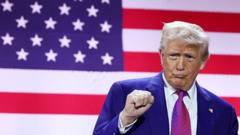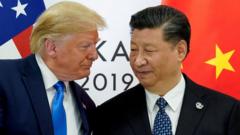Despite the Chinese government’s push for increased domestic consumption to offset losses from U.S. tariffs, consumer spending remains hesitant, showcasing an underlying weakness in China’s economic recovery.
China's Consumption Dilemma amid Trade Tensions

China's Consumption Dilemma amid Trade Tensions
As U.S.-China trade relations sour, Beijing urges domestic spending to strengthen the economy, yet consumer reluctance signals a more complex reality.
China's bustling shopping districts paint a vibrant picture amid escalating trade tensions with the United States. As consumers in areas like Guangzhou flock to cafes and boutiques, the Chinese government is pinning its economic hopes on domestic spending to counteract the impacts of the ongoing trade war. With President Trump's tariffs set at a staggering 125% on Chinese goods, Beijing is battling back with steep tariffs of 84% on U.S. imports. However, a recent commentary from People’s Daily suggests that despite these challenges, China will leverage its vast consumer market to drive economic growth.
Yet, the shift towards consumption isn’t straightforward. Domestic demand has faced significant headwinds even prior to the tariff escalation. The post-pandemic economic landscape reveals a struggle, as many factories have closed and youth unemployment remains alarmingly high. Further complicating matters, soaring home prices that traditionally supported middle-class wealth have dramatically fallen.
Even the vibrant scenes at prominent shopping locales like Taikoo Li in Beijing may mask deeper troubles. Observations on the ground reveal that consumers are increasingly cautious; while they may venture out to shop, many are only seeking deals or simply browsing without making purchases. Qu Nan, a 38-year-old construction entrepreneur, exemplifies this trend. Meeting friends in a bustling Starbucks, he opts not to buy anything, indicative of a broader hesitance that could hinder China’s aspirations to boost domestic consumption and drive economic stability in these turbulent times.
Yet, the shift towards consumption isn’t straightforward. Domestic demand has faced significant headwinds even prior to the tariff escalation. The post-pandemic economic landscape reveals a struggle, as many factories have closed and youth unemployment remains alarmingly high. Further complicating matters, soaring home prices that traditionally supported middle-class wealth have dramatically fallen.
Even the vibrant scenes at prominent shopping locales like Taikoo Li in Beijing may mask deeper troubles. Observations on the ground reveal that consumers are increasingly cautious; while they may venture out to shop, many are only seeking deals or simply browsing without making purchases. Qu Nan, a 38-year-old construction entrepreneur, exemplifies this trend. Meeting friends in a bustling Starbucks, he opts not to buy anything, indicative of a broader hesitance that could hinder China’s aspirations to boost domestic consumption and drive economic stability in these turbulent times.






















